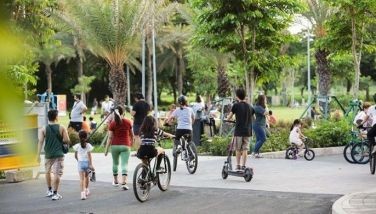Our compromised future

According to the World Bank, 80 percent of Filipino children don’t know what they are supposed to know. Let that sink in and panic.
One in every four Grade 5 students does not have the reading and mathematics skills for Grade 2 or 3. Four in every five 15-year-old students do not understand basic mathematical concepts such as fractions and decimals that should be mastered by fifth graders.
The future of our country is compromised. We are growing generations of Filipinos whose skills to have a good life in today’s world are minimal.
Our hopes for taking advantage of the so-called demographic dividend are dashed.
A NEDA explainer released when Ernie Pernia was director general, noted that “the Philippines is expected to be the last major Asian economy to benefit from the demographic dividend between the years 2025-2070.”
NEDA warned that “if not properly addressed, the country would need to wait until at least 2050 to benefit from the demographic dividend or possibly miss it all together.”
What is the demographic dividend? Here is NEDA’s explanation:
“In a nutshell, demographic dividend is the economic growth experienced by a country as a result of the change in the country’s population structure.
“It is the product of the demographic transition, which is characterized by markedly declining mortality and fertility rates, resulting in the shrinking of the dependent age (0- to 14) group and expanding of the workforce (ages 15 to 64). This transition leads to steadily rising savings and investment rates and, hence, faster economic growth and improved living standards.
“Demographic transition has three phases. An initial decline in infant mortality (death rate), with fertility rate remaining high, marks the first phase of the demographic transition. The second phase happens when the share of working-age population becomes large relative to the young dependent ages and the older population (65 years and above).
“With the number of productive working-age population at its highest, the economy’s growth sharply accelerates. With a bigger workforce that can generate higher income and a less dependent population, the government can allocate its resources for economic development and social services (education, health and nutrition) …
“The success stories of the Philippines’ neighboring countries are examples of how governments can fully maximize the dividend from this demographic transition… Singapore and Thailand got to this point in the 1990s.
Pernia pointed out early in his watch that “the government must invest in human capital through family health and educational interventions. The time is ripe to lay down the foundation for the Philippines to harness its demographic dividend.”
Such is the sad state of education in the Philippines that emerged in three different multi-country assessments spearheaded by the World Bank (WB).
Across the three assessments, the Philippines performed poorly compared to nearly all other participating countries, ranking at or near the bottom in each learning area assessed.
The country was last in reading and second to last in science and mathematics among 79 countries in Pisa. In TIMSS, it ranked last in both mathematics and science among 58 countries in the fourth-grade assessment. In SEA-PLM, it was among the bottom half of the six countries in reading, mathematics, and writing literacy.
The World Bank declared “there is a crisis in education – which started pre-COVID-19, but will have been made worse by COVID-19.” Across the three global assessments, only 10 to 22 percent of Grade 4, 5, and 9 students in the Philippines posted scores “at or above minimum proficiency.”
The World Bank also noted the three assessments showed a special concern on bullying.
Among all participating countries, TIMSS found that Grade 4 students were most frequently exposed to bullying in the Philippines. Similarly, of all participating countries in SEA-PLM, the proportion of Grade 5 students who agreed that they felt safe in school was lowest in the Philippines. In Pisa, the magnitude of bullying as reported by 15-year-olds was higher in the Philippines than in all other participating countries.
TIMSS showed that 45 percent or nearly every other Grade 4 student in the Philippines reported weekly bullying in their schools or way above the average of eight percent across the 64 participating countries.
Pisa also showed that two out of every five 15-year-old students said they had been “frequently bullied” – five times bigger than the eight percent average in 79 countries which took the assessment.
Yet, the World Bank noted, teachers and principals reported relatively fewer physical fights, intimidation among students, as well as student learning hindered by intimidation or bullying, the Pisa and TIMSS results showed.
So, here we are. A fast-growing young population not equipped with the skills to help themselves and the economy to move forward faster. They will just add to the ranks of the underemployed and unemployed and be a continuing drag on the economy.
The only work options for most of them are as domestic helpers, construction workers and ship crew members. Since there are millions of them, maybe they can sustain the current level of OFW remittances indefinitely.
But we have to suffer the continuing social costs of separated families that include drug addiction and delinquency. The future looks grim, especially because it will take more than two or three presidencies to overhaul DepEd and get our education system straight… assuming we elect the right presidents.
Forget the BPOs. Not only will technology move jobs back to the US and other developed countries. Our English proficiency edge is fast eroding. I got a good laugh when Kris Aquino, in responding to a Twitter basher, corrected the troll’s English instead.
Indeed, the World Bank also pointed out that part of our problem is that students do not understand English, the language used for instruction. That was blamed for low marks even in Math and Science.
Supporting private education may be a good temporary answer, but private schools are closing down fast due to bad economics of the business.
As for the bullying in schools, blame the bad example from our politicians including the one in the highest office… the bully-in-chief. A culture of impunity is now upon us.
Hay naku…
Boo Chanco’s e-mail address is bchanco@gmail.com.
Follow him on Twitter @boochanco
- Latest
- Trending























